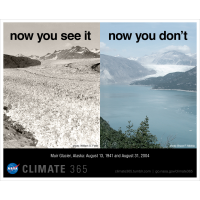All the Glaciers in Glacier National Park Could be Gone in 15 Years
 (photos: Glacier National Park Archives)
(photos: Glacier National Park Archives)
In just 15 years, Glacier National Park may be in need of a new name.
The natural wonder has attracted tourists for generations; a hundred years ago it had as many as 150 ice sheets.
But global warming has taken its toll on Glacier National Park, which by 2030 may lose all of its current glaciers, about 25, according to the U.S. Geological Survey (USGS).
And it’s not just glaciers that are disappearing. Water for irrigation downstream is drying up and the trout population has fallen to the point where anglers must catch and release them instead of having them for dinner, according to The New York Times.
The park is warmer all year round. There are three times as many 90-degree-plus days in the summer as there were a century ago and the cold of winter doesn’t last as long.
The agency is now frantically documenting what’s left of the park’s namesakes. A program is underway to photograph the ice sheets before they turn to water.
If that occurs as projected, National Park officials will have to decide whether to keep the name to reflect what once was, or amend it to reflect what will be: no glaciers.
-Noel Brinkerhoff, Steve Straehley
To Learn More:
Climate Change Threatens to Strip the Identity of Glacier National Park (by Michael Wines, New York Times)
USGS Repeat Photography Project Documents Retreating Glaciers in Glacier National Park (U.S. Geological Survey)
Retreat of Glaciers in Glacier National Park (U.S. Geological Survey)
Global Warming in Alaska Reveals Remains of 1952 Air Force Crash (by Noel Brinkerhoff, AllGov)
- Top Stories
- Unusual News
- Where is the Money Going?
- Controversies
- U.S. and the World
- Appointments and Resignations
- Latest News
- Trump to Stop Deportations If…
- Trump Denounces World Series
- What If China Invaded the United States?
- Donald Trump Has a Mental Health Problem and It Has a Name
- Trump Goes on Renaming Frenzy






Comments